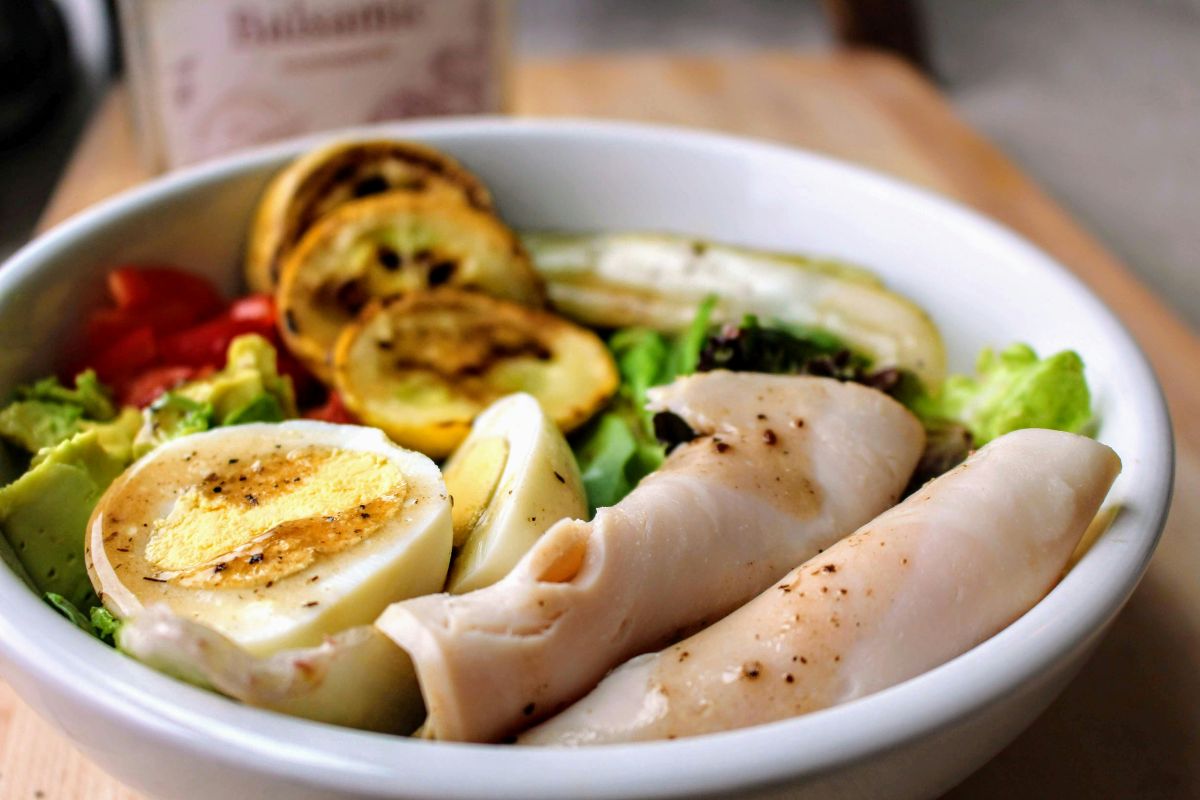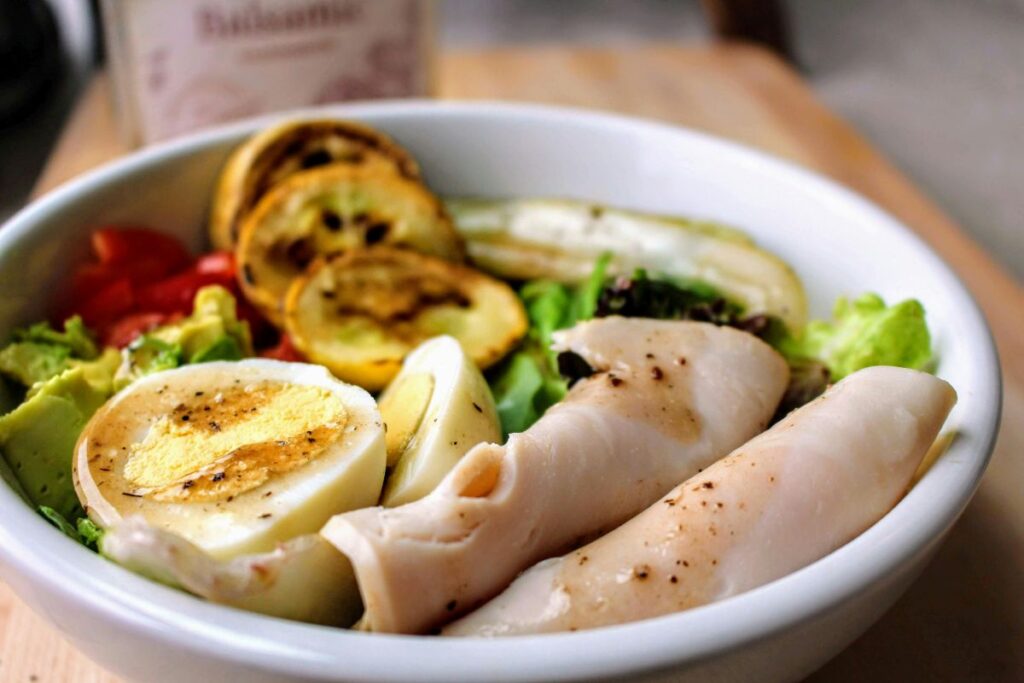
7-Day Ketogenic Diet Sample Meal Plan
The ketogenic diet is extremely popular among athletes, especially bodybuilders, as we often hear about competitors who have easily lost weight and body fat with the help of the ketogenic diet. However, there is a lot of contradictory information about its effects on the body. What are the conditions for reaching a ketogenic state, and how long can this diet be maintained? You’ll find out if you keep reading!
The Basics of the Ketogenic Diet
The ketogenic diet is a very low-carbohydrate, high-fat diet. In addition to low carbohydrate intake, it is also characterized by moderate protein consumption.
Due to the low carbohydrate intake, the body enters what is known as a ketogenic state (begins producing ketone bodies), as a result of which fat becomes the primary source of energy.
Ketone bodies become the brain’s main source of energy. Since the body continuously uses fat as an energy source during the production of ketones, continuous fat burning begins. This is when we refer to ketosis.
There is no insulin present in the blood because there is very little carbohydrate to raise blood sugar levels and stimulate insulin production. As there are no fluctuations in blood sugar, energy supply becomes stable and consistent, weight loss continues steadily, you feel less hungry, and your ability to concentrate improves. (1)
To reach the ketogenic state, or to begin the production of ketone bodies, the body’s carbohydrate stores must be depleted — perhaps the most difficult part of the diet — since this requires avoiding carbohydrates for several days and/or engaging in intense exercise to speed up the process. Once ketone production begins, energy levels return and stabilize, but getting to that point requires effort and persistence.
The ketogenic diet is a sustainable approach for most people, but there are exceptions for whom it is not recommended. The ketogenic diet is not advised for the following three groups: (2)
- Diabetics (especially those with insulin dependency)
- Individuals with high blood pressure, particularly those taking medication for the condition
- Pregnant or breastfeeding mothers (3)
Shopping List for the Ketogenic Diet
Curious about what you can actually eat on the ketogenic diet? It’s especially important to pay close attention to the nutritional content of foods. Carbohydrate intake must be minimized — this is the most important rule — but protein and fat content should also be monitored.
Protein sources:
| Freely Consumable | Occasionally Consumable | To Be Avoided |
|---|---|---|
| Beef | Bacon | Cold cuts |
| Fish (e.g., salmon) | Chicken breast fillet | Meats flavored with sugary sauces |
| Chicken thighs (drumsticks) | Breaded meats (e.g., schnitzel) |
Oils and fats:
| Freely Consumable | Occasionally Consumable | To Be Avoided |
|---|---|---|
| Avocado oil | Sunflower oil | Margarine |
| Olive oil | Corn oil | Artificial trans fats |
| Coconut oil | Safflower oil | |
| Butter, cream |
Fruits and vegetable
| Freely Consumable | Occasionally Consumable | To Be Avoided |
|---|---|---|
| Avocado | Leek | Potato |
| Leafy greens (e.g., spinach) | Eggplant | Corn |
| Celery | Spaghetti squash | Raisins, other dried fruits, sugary fruits |
| Asparagus |
Nuts
| Freely Consumable | Occasionally Consumable | To Be Avoided |
|---|---|---|
| Walnuts | Sugar-free almond and peanut butter | Nuts and seeds mixed with dried fruits |
| Almonds | Cashews | Sweetened nut butters |
| Flaxseeds and chia seeds | Pistachios | Chocolate-covered nuts |
Dairy products
| Freely Consumable | Occasionally Consumable | To Be Avoided |
|---|---|---|
| Cheddar cheese | Full-fat cottage cheese | Milk |
| Blue cheese | Full-fat Greek yogurt | Sweetened yogurt |
| Feta cheese | Full-fat ricotta | Ice cream, frozen desserts |
Sweeteners
| Freely Consumable | Occasionally Consumable | To Be Avoided |
|---|---|---|
| Stevia | Xylitol | Agave |
| Erythritol | White and brown sugar, honey | |
| Maple syrup |
Dressings and Sauces
| Freely Consumable | Occasionally Consumable | To Be Avoided |
|---|---|---|
| Guacamole | Raw garlic | Barbecue sauce |
| Sugar-free mayonnaise | Sugar-free tomato sauce | Ketchup |
| Balsamic vinegar | Honey mustard sauce |
Drinks
| Freely Consumable | Occasionally Consumable | To Be Avoided |
|---|---|---|
| Water | Black coffee | Sugary sodas |
| Almond milk | Unsweetened sparkling water | Fruit juices |
| Plain tea | Calorie-free drinks | Lemonade |
| Bone broth |
Herbs and Spices
| Freely Consumable | Occasionally Consumable | To Be Avoided |
|---|---|---|
| Salt | Ginger | – |
| Pepper | Garlic powder | – |
| Oregano, paprika, thyme | Onion powder | – |
Supplements
| Recommended | Optional |
|---|---|
| Fiber tablets | MCT oil |
| Multivitamin | Omega-3 fatty acids |
7-Day Sample Meal Plan for the Ketogenic Diet
Let’s go over how to calculate your daily calorie intake and the ideal macronutrient ratios. In a less strict ketogenic diet approach, the allowed daily carbohydrate intake is a maximum of 20g for the first two weeks, after which this amount is gradually increased. In terms of nutrient ratios:
- 60-70% Fat: The majority of your calorie intake should come from fat. It is advisable to consume healthy, quality fat sources such as olive oil, coconut oil, eggs, avocado, cheeses, fish, etc.
- 20-30% Protein: Protein intake should be moderate in a ketogenic diet, primarily from amino acids that the organs unable to utilize ketones can use. Higher protein intake can hinder ketosis. However, minimizing protein intake too much can result in muscle mass loss, so finding the right balance is important.
- 5-10% Carbohydrates: Limit your daily carbohydrate intake to a maximum of 20-40g. Pay special attention to fiber intake and ensure that your carbohydrate sources come mainly from vegetables rich in vitamins and minerals.
Sample Meal Plan:
Most people can achieve a ketogenic state with a carbohydrate intake of 50g. In this meal plan, the carbohydrate intake is around 20g on average. It’s important to drink 2.5-3 liters of fluids daily. Inadequate fluid intake can lead to dizziness and sugar cravings. It’s also advisable to pay attention to proper electrolyte intake with a little extra salt.

Monday:
- Breakfast: Onion and cheese scrambled eggs
- Mid-morning snack: Sugar-free peanut butter protein bar
- Lunch: 150g raw ham with 2 cups mixed vegetables, half an avocado, 5 large olives, half a cup of sliced cucumber, and 2 tablespoons blue cheese dressing
- Afternoon snack: Small sliced zucchini with 50g provolone cheese
- Dinner: Butter-baked catfish with broccoli
Tuesday:
- Breakfast: Spinach and cheese omelette
- Mid-morning snack: Protein shake
- Lunch: Grilled chicken with baby spinach, tomato, and avocado salad
- Afternoon snack: Dill cream cheese with 60g ham
- Dinner: 200g pork chops with cauliflower cheese cream
Wednesday:
- Breakfast: Fried sausage with cucumber and tomato
- Mid-morning snack: Sliced green pepper
- Lunch: Ham and cheddar cheese soup
- Afternoon snack: 1 stalk of celery with 2 tablespoons cream cheese
- Dinner: Beef slices with vegetable side
Thursday:
- Breakfast: Cheese and spinach omelette with avocado and salad
- Mid-morning snack: Protein shake
- Lunch: Roast chicken thighs with salad
- Afternoon snack: Zucchini slices with cheese sauce
- Dinner: Baked trout fillet with cucumber
Friday:
- Breakfast: Scrambled eggs from 2 large eggs with sliced cheddar cheese
- Mid-morning snack: 1 smoothie
- Lunch: Canned tuna with vegetables and olives
- Afternoon snack: Stuffed mushroom caps with seasoned ground meat, bacon, and cheese
- Dinner: Chicken salad with flaxseed oil
Saturday:
- Breakfast: Asparagus fried eggs
- Mid-morning snack: Sugar-free protein bar
- Lunch: Grilled salmon with broccoli
- Afternoon snack: Celery stalks with cheese sauce
- Dinner: Beef with blue cheese sauce, mixed salad with flaxseed oil dressing
Sunday:
- Breakfast: Bell pepper stuffed with vegetable scrambled eggs
- Mid-morning snack: Cheese with boiled green peas
- Lunch: Chicken breast with roasted vegetables
- Afternoon snack: Grilled cheese with celery stalks and tomatoes
- Dinner: Baked trout with broccoli
Sources:
(1) https://www.healthline.com/nutrition/ketogenic-diet-101#what-it-is
(2) https://www.ncbi.nlm.nih.gov/books/NBK499830/
(3) https://www.ncbi.nlm.nih.gov/pmc/articles/PMC8610544/